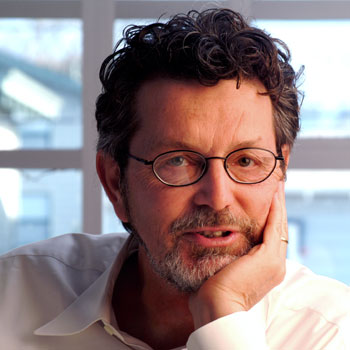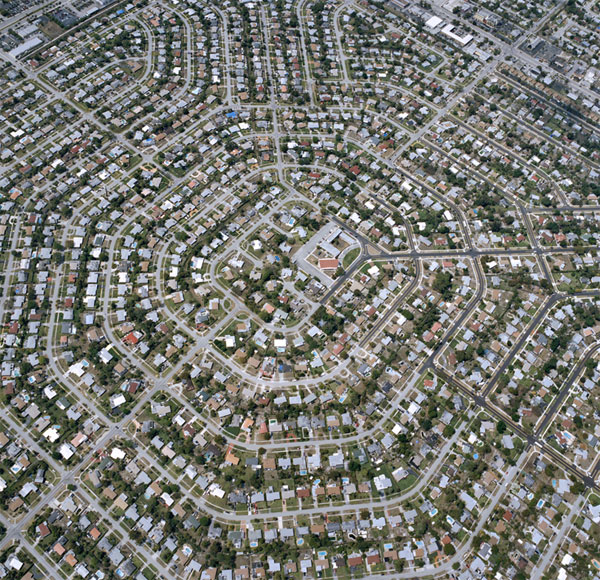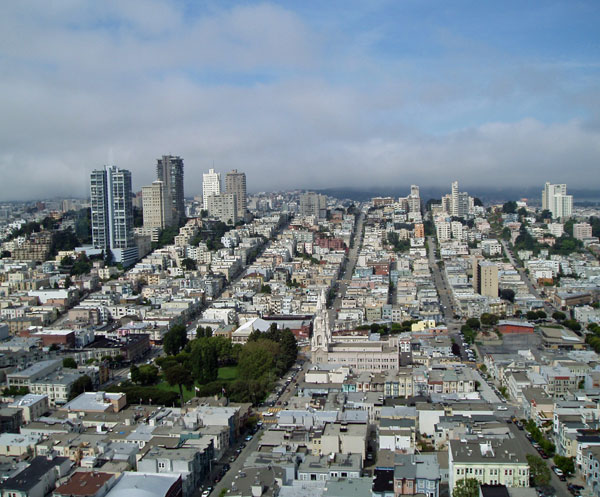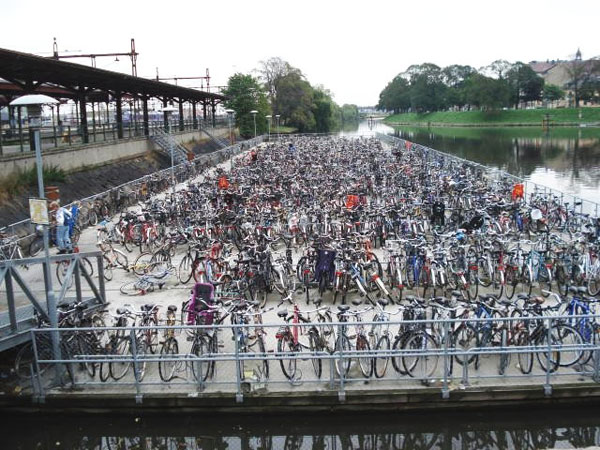News
Interview with Peter Calthorpe
 Image credit: Calthorpe & Associates
Image credit: Calthorpe & Associates
In your new book, "Urbanism in the Age of Climate Change," you argue that "urbanism is the foundation for a low carbon future," and the most cost effective solution to climate change, even more so than renewable energy. Urbanism allows us to do more with less. What is urbanism? Why is urbanism the solution?
There’s no great urbanism without a walkable environment, without active streets, and without diverse communities. Good urbanism has these three basic principles: One is human scale, which has to do with designing public spaces around the pedestrian rather than the car. Ironically, human scale can exist in incredibly dense places, like Manhattan, or in relatively low density places, like the historic centers of our rural towns. While there's a huge variety, they are walkable, human scale, and the end result is still urban. Diversity is another key ingredient of urbanism and basically says that you have to have a range of uses mixed together, you can't isolate housing and shopping and employment into separate zones. But also you need a diverse population -- you can't isolate age groups, income groups, and family types. Those two fundamental principles, human scale and diversity, are always at the heart of urbanism, whether it’s in a city context or in a small town context. That’s one of the most important messages. The third principle, which wasn’t historically part of urbanism, is conservation and restoration. It used to be that a city would pretty much plow over whatever got in its way, whether it was wetlands or any aspect of the natural environment. There needs to be a greater sensitivity to the ecological context. But I think we can weave different kinds of urbanism around the ecological framework that we want to preserve and enhance.
Cities also remake themselves -- demolish and
rebuild all the time -- and I think that’s a very important part of
urbanism. The resilience of the urban fabric is that it can be renewed
and redone. However, a greater sensitivity to history, historic
resources, and cultural resources have to be part of urbanism now. So,
those three principles: conservation, both in terms of the environment
and in terms of culture and history; human scale, which translates into
creating pedestrian environments that work; and diversity, which means
you have to create mixed use communities for a full range of people.
That’s at the heart of what I mean when I say urbanism. That then easily
translates into what would be the best foundation for a low carbon
future.
The urban solution involves both technology and design. For example, we will need to dramatically reduce the number of miles we drive as well as develop less carbon intensive vehicles. It will mean living and working in buildings that demand significantly less energy as well as powering them with renewable sources. It will involve the kinds of food we eat, the kinds of homes we build, the ways we travel, and the kinds of communities we inhabit. It will certainly involve giving up the idea of any single “silver bullet” solution (whether solar or nuclear, conservation or carbon capture, adaptation or mitigation) and understand that such a transformation will involve all of the above--and, perhaps most important, that they are all interdependent.
You advocate a "whole systems" approach rather than a checklist approach for redeveloping communities, reducing energy usage, and addressing climate change. In practical terms, how can a systems approach be used to achieve the most sustainable model of urbanism, you identify: green urbanism?
The problem with the environmentalists that are advocating for action on climate change now is they tend to create a checklist of technologies as a solution. If you look at Al Gore’s new book, it is just a compendium of different technologies that can be stacked up one on the other to solve the problem. It doesn’t really change the kinds of cities we live in, the kinds of communities we inhabit; it doesn’t address our lifestyle. It basically says we can solve it all with a new piece of technology. It’s the thinking that the electric car is the single solution, rather than reducing the amount of travel that we need to live our lives in a healthy and robust way. In the end it will take both.
The problem with the technological approach is that it’s single-minded and it misses out on all the co-benefits that come from good urbanism. The reason urbanism is such a cost effective solution is that it solves more than the carbon problem. It creates a broader range of housing, which is really needed now in America; with the real estate crash we all understand that a big part of that was driven by the fact that we overbuilt one market segment (large lot, single family) to the point where it lost value in a dramatic way.
 Image credit: Single family, large-lot homes. Eden Prairie, Florida /
Image credit: Single family, large-lot homes. Eden Prairie, Florida /
Our household types and
our age groups, our demographics are beginning to push us towards a
whole different range of housing types, most of them more urban, and if
we follow that, we satisfy the market needs for the kinds of lifestyles
and affordability. In the housing market, we simultaneously begin to
solve the climate change issue. Other co-benefits have to do with
obviously just higher density leading to more land conservation and
lower water demand (which are a big issue out here in the west), and
lower levels of infrastructure investment, which translates back into
affordability, not just for the climate change solution, but more
affordability for everyday life.
The whole systems approach looks at a broad range of problems that need to be addressed and tries to find solutions that synthesize those problems and begin to find common solutions. The engineering mentality is always to take one issue at a time, and because of that, we lose the possibility of being real good designers. Take for example, streets. If you approach streets with an engineering mentality and only focus on how you move the most number of cars most efficiently, you get one type of street. If you think of the street as having many agendas, like walking, biking, cars, lingering, meeting, the ecology of street trees (both in terms of micro climate and as habitat), when you begin to think about all the different functions of a street and you design for all of them rather than one, you get a much richer environment and once again you solve many problems simultaneously.Open space corridors, such as rivers, ridge lands, wetlands, and forests could be the village green at a metro level and the commons of the region. Furthermore, you say regional plans are needed to put in place more progressive policies that preserve open space. Why is open space so important? What is the relationship between open space and density, which you say is also critical to achieving sustainable development?
You have several issues packed together there. One is that the solution isn’t so much that everybody needs to live in a city, but people need to live in regions that offer a huge range of living environments and community types. The question is what knits all that together? Transit is one substructure that can knit it together in a healthy environmental way, but open space systems are the other. We now tend to live in regional communities. Our job and economic opportunities are regional, they’re not within any one jurisdiction. Most of our environmental impacts are regional. Air quality impacts, obviously, occur over a much larger geography than individual towns and cities and counties. Water quality, the same, and of course, underlying all that is an open space network that respects and protects the most valuable natural resources in an area, and then uses those as a framework, as the kind of common ground at the regional scale, to reinforce that common identity.
Quite frankly, many people see themselves as fragments, living in small isolated places in the context of a zero-sum game. My suburban town doesn’t need to do affordable housing because some other town or downtown is doing it. That parochial view needs to be broken down by things that really unify and make us citizens of the region. The respect for the environmental context is what creates identity and common ground at the regional scale. There are other things at the regional scale -- the diversity of economy, and the kinds of linkages, and transportation nexus that happens are all really key to creating sustainable communities. So you can't solve the problem at the scale of the individual houses, much as people would like to think just putting some solar panels up, and buying a different car will solve the problem. You can't really solve the problem at the scale of the individual, town or county, but the regional scale is actually the important one in terms of the global economic context. It's also the scale at which we can solve the most critical environmental issues.
Between 1977 and 1995, the average amount Americans walk per day fell 42%, while automobile use grew at three times the population growth. What is behind the dramatic decrease in walking? Has there been an uptake since 1995? Also, do you think people are waking up to the fact that the built environment is the primary cause of the growing obesity epidemic and are therefore now demanding more walkable communities?
A segment of the population is waking up to all the connections, and I don’t think it takes a rocket scientist to demonstrate that if you design communities around a car, you're going to have increased automobile use. For generations now, that’s exactly what we’ve been doing. This notion of urbanism in its best sense is to aid communities that don’t have that profound bias come up with a new approach, not so much in the abstract but in reality, today. We can actually go and measure it today, across the Bay Area where I live. If you live in a three story neighborhood in San Francisco, the average vehicle miles traveled per year by that household is around 7,000. If you live in a kind of two story bungalow neighborhood, used to be part of the old street car system, over in North Oakland, called Rockridge, it’s around 12,000 VMT. If you live out in the traditional suburb, in San Ramon, you're over 30,000. So there’s a four to one shift there in auto dependence and the reverse of that of course is more walking and more biking and more transit use. It's not an abstract thing, it’s a real thing. It’s here today. What is the right mix of community types for the next generation? In the end, it boils down to more places like Rockridge and neighborhoods in San Francisco, and less places like San Ramon.
 Image credit: San Francisco skyline / T13Harvey, Panaramio
Image credit: San Francisco skyline / T13Harvey, Panaramio
Transit oriented development (TOD) is "regional planning, city revitalization, suburban renewal, and walkable neighborhoods rolled into one.” In layman’s terms, why is TOD so central to sustainable community development? What do successful TOD projects share in common?
The idea of transit oriented development (TOD) is really central because it links the region together in ways that we need to link. The idea that everybody is going to live, work, and play in the same neighborhood is not realistic. People are always going to travel to their best job opportunity. The question is what travel choices do they have?
The idea of transit oriented development is very simply that you need to conveniently walk to local destinations and transit opportunities that connect you to all sorts of regional opportunities, whether it’s jobs or unique regional cultural or environmental resources. Living within walking distance of transit and creating a neighborhood around the transit that is convivial to walk in is at the foundation of how you would reform our existing suburbs. A lot of people ask, “Well, you know, we’ve built all this auto-dependent environment, now we have to live with it.” It’s actually very easy to retrofit it. Using TOD and putting transit down big arterials and then infilling the clusters of density and creating diversity at the stations is a way of reinventing the suburb. At the same time, you're connecting a lot of suburban environments to a polycentric set of destinations throughout the region. It's a way to renovate and connect. It's a way to provide affordable housing opportunities throughout the region.
One indicator you view as critical is vehicle miles traveled (VMT), which policymakers and players can map per household in different communities. Why are low rates of VMT such an important indicator of sustainable communities? How many communities are collecting and tracking this data now?
It's a very important indicator because different places can lead to many different outcomes in terms of travel behavior. You can have areas where people use lots of transit, other areas where they bike a lot, and then, in some of our densest, urban areas, pedestrian and walking becomes dominant. The key here is all of those are benign alternatives. The key is just to reduce VMT, because VMT represents carbon emissions, oil dependence, and the need for a lot of asphalt and roads, and a lot of construction costs. VMT represents the need for huge parking structures or parking fields, the diminution of the human scale and the pedestrian environment. There are many ways to reduce it.
Let me give you a good example: Sweden, the mode split, which is a traffic terms for how people travel, is over 50% walk/bike, and it’s only around 15% transit. We tend to think of transit as the big alternative to the car, but the reality is, in many circumstances, the alternative is the pedestrian and biking, and as a matter of fact, you can't have a great transit system without walkable origins and walkable destinations. You're literally stranded if you use transit and arrive in a place where you need a car. Walk/bike is really the foundation of this whole thing. They all contribute to reducing the VMT, and the VMT is, of course, what leads to most of the negative impacts of our built environment, whether it’s air quality and the impact on respiratory disease, or the amount we walk and the obesity that comes out of that, or the amount of land we consume per household and the amount of asphalt we have to lay down, and therefore the amount of runoff and water degradation we create, or the quantity of energy we need and all the implications that represents.
 Image credit: Malmo, Sweden Bike Station / 5BBC
Image credit: Malmo, Sweden Bike Station / 5BBC
In "Makeshift Metropolis," Witold Rybczynski says the New Urbanism movement has had grand ambitions to remake the center of cities, but its successes have largely been in the suburbs. In fact he quotes Vincent Scully who says “the New Suburbanism might be a truer label.” Do you think this is true? If so, has New Urbanism had a positive environmental impact, particularly considering many new suburban communities have been built on undeveloped land?
I’m a big believer that all of the above is necessary to make our regions thrive. We need urban infill and revitalization. We need to rebuild existing suburbs, and for most expanding regions, they will be and needs to be greenfield development. It has to be done in the right place, with the right urban design principles. The notion that New Urbanism set out to actually define all three of those domains is, I think correct. You get into the world of publicity and the media, and they tend to focus on the large greenfield projects, which I think are necessary and important. If you can create a greenfield project, like Stapleton for example in Denver, that has four times the density of the traditional suburb, and has mixed use and walkable environments, and has proven itself as more desirable -- people actually spend more money per square foot of house there even though they’re getting smaller yards. I think that’s a big step forward.
Another big step forward of course, would be at the other end of the spectrum, the Hope VI Program, which Congress for New Urbanism (CNU) worked on very closely with Housing and Urban Development (HUD) Secretary Cisneros, to replace public housing (what I call high rise sprawl) with great urban neighborhoods, which once again are walkable, diverse, and respect the history of their place. New Urbanism is being successful at all the levels. A few of the practitioners, have also succeeded with regional plans, that lay out whole new transit networks, preserve open space at the regional scale and lead to more contact and communities, and more infill. That’s actually a success of the New Urbanism movement that is rarely recognized. The danger is always falling into stereotypes. It’s easy to stereotype the CNU, but I think they’ve accomplished a lot in all of those domains: regional planning, urban revitalization, and re-framing how we build suburbs.
Lastly, is there a popular demand for the new Green Urbanism approach you propose? Is it just a matter of promoting the many sustainable design strategies you mentioned at the street level so communities can see that there is something other than the status quo? If that’s the case, what role can landscape architects play?
The market forces already at work will make urbanism the core of the next generation of growth in America. A noted demographer, Chris Nelson, has done extensive studies both in the country and in California that show that the market is now for small-lot single family, townhouse and condominium apartments. There is no market demand left for large-lot, single family in metropolitan America. As a matter of fact, the market is saturated through the year 2035. The need is for a different housing -- more compact urban housing -- is already manifest in the market. We can frame that as good urbanism, creating beautiful, walkable streets and supporting it with adequate transit and making sure that they are truly mixed-use environments.
The public sector has to create the right kind of plans to satisfy the market demand. We need to go about the business of revisiting almost all of our general and comprehensive plans as well as zoning ordinances and that’s a huge undertaking. The bottom line is there’s a large market for townhouses, but who wants to live in a townhouse without a town, and the danger is that unless we create these great urban places, the market demand for higher density housing won’t be realized in quite the way that it should. Standing in the way are local communities that are simplistically against change, fearful of change, diversity, and infill and even revitalization. It’s not going to be easy, but at least at this stage we have the ideas and the design principles are clearly in hand. We have best practices examples that already built. We have the analytical tools to actually make the case, whether it’s in terms of physical or environmental impacts, but we still have to overcome the giant NIMBY reaction against change. That is going to be our most formidable hurdle.
There needs to be education so the next generation that’s out looking for their first home can understand there are choices other than driving great distances to get an affordable house in the suburbs. Underneath it all, we need to rethink the hierarchy at the regional scale – the range of choices and how they are connected. We need regional plans that do a really good job of environmental conservation, transit, and an equitable distribution of affordable housing. Those regional plans need to then drive the local planning efforts, so there needs to be a lot more pressure on local jurisdictions to provide their fair share of workforce housing. Too many local jurisdictions, especially wealthy suburbs say, “We’re not interested in change. We’re not interested in adding affordable housing even if it’s for our teachers and firemen.” There needs to be political mechanisms to create a little more impetus towards change. Also we need to make the right investments. A lot of our urban centers are on the upswing now, largely because of demographics and people realizing how valuable an urban life is, and yet we don’t have public dollars to maintain the infrastructure. Arcing over all of this and never to be ignored, is our education system. It used to be that people would move to suburbs for better schools. Now they can't even find better schools there. We need to level the playing field in terms of education. You shouldn’t need to sacrifice your kid’s education in order to live in a great urban place, so we need to solve the education problem in general.
Landscape architects are at the heart of this because in so many circumstances they are the community planners. It's frightening -- in some circumstances, community planners are civil engineers who just lay out streets and storm drains, one subdivision, one piece at a time. Architects, tragically, have turned their back on much of this because they still are fixated on the isolated building. Planners tend to create very vague documents that really don’t go to the heart of physical design. To a certain degree, I think landscape architects can be the ones most responsible for getting it right, but they have to shift their view so that they see great urban spaces as important green environments and not just natural environments. They need to move beyond McHarg to a much more proactive urban design ethic. They need to think of streets as ecologies and design them as such. A certain shift in the way they approach design is needed, but I think if they do it right, they’re the ones who can begin to synthesize the issues and meet a lot of these needs.
Peter Calthorpe, author of "Urbanism in the Age of Climate Change," is principal of Calthorpe Associates and was named as one of the 25 "innovators on the cutting edge" by Newsweek magazine for his work redefining models of growth in America. In the early 90’s, Calthorpe developed the concept of Transit Oriented Development (TOD), which was highlighted in his earlier book, "The Next American Metropolis: Ecology, Community, and the American Dream." Calthorpe, a founder of the Congress for New Urbanism (CNU) and its first board president, has created regional plans for Portland, Salt Lake City, Los Angeles, and post-hurricane Southern Louisiana. Recently, in California, he led a state-wide urban design effort, Vision California, to inform the implementation of the state’s climate change legislation.
Interview conducted by Jared Green.